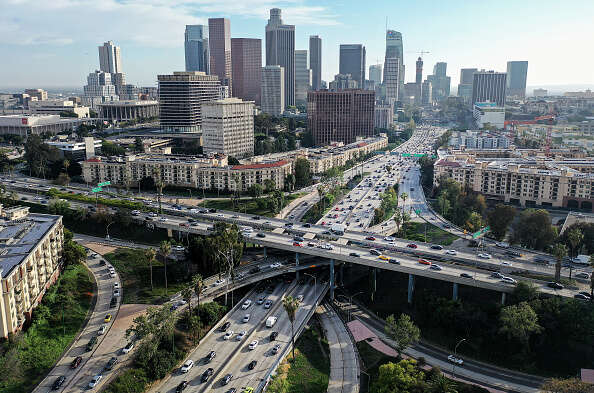
In the American Lung Association’s recently released State of the Air report for 2023, the nation received both good news and a sobering reminder of persistent air quality challenges. The report, which evaluates air quality in cities and counties across the US, revealed notable improvements in some areas but also highlighted ongoing concerns related to pollution, climate change and disparities among communities.

One of the positive findings in the report was a decrease in the number of Americans living in areas with unhealthy levels of air pollution. The report noted that nearly 36% of Americans, approximately 119.6 million people, still reside in places with failing grades for unhealthy levels of ozone or particle pollution. While this number remains substantial, it represents a reduction of 17.6 million individuals compared with the previous year.
The improvement in air quality can be attributed to improvements in the ozone in many regions, demonstrating the continued success of the Clean Air Act in addressing pollution sources. This positive trend reflects decades of effort to reduce emissions from transportation, power plants and manufacturing facilities.
Despite the overall progress, the report sounded alarms about daily spikes in deadly particle pollution. A staggering 63.7 million people were living in counties with failing grades for daily spikes in particle pollution, marking the highest number ever reported under the current national standard. This concerning trend underscores the need for continued efforts to combat particle pollution, which poses significant health risks.
Cities with the worst and best air quality
The report highlighted the cities and metropolitan areas with the most and least polluted air. Bakersfield, California, was named the metropolitan area with the worst short-term particle pollution, while also retaining its position as the most-polluted city for year-round particle pollution, tying with Visalia, California. Los Angeles remained the city with the worst ozone pollution, as it has for nearly a quarter-century.
Most polluted cities by ozone air pollution
- Los Angeles-Long Beach, CA
- Visalia, CA
- Bakersfield, CA
- Fresno-Madera-Hanford, CA
- Phoenix-Mesa, AZ
- Denver-Aurora, CO
- Sacramento-Roseville, CA
- San Diego-Chula Vista-Carlsbad, CA
- Houston-The Woodlands, TX
- Salt Lake City-Provo-Orem, UT
Most polluted cities by year-round particle pollution
- Bakersfield, CA
- Visalia, CA
- Fresno-Madera-Hanford, CA
- Los Angeles-Long Beach, CA
- Fairbanks, AK
- Sacramento-Roseville, CA
- Medford-Grants Pass, OR (joint #7)
- Phoenix-Mesa, AZ (joint #7)
- San Jose-San Francisco-Oakland, CA (joint #7)
- Indianapolis-Carmel-Muncie, IN
Most polluted cities by short-term particle pollution
- Bakersfield, CA
- Fresno-Madera-Hanford, CA
- Fairbanks, AK
- Visalia, CA
- Reno-Carson City-Fernley, NV
- San Jose-San Francisco-Oakland, CA
- Redding-Red Bluff, CA
- Sacramento-Roseville, CA
- Chico, CA (joint #9)
- Los Angeles-Long Beach, CA (joint #9)
The report highlighted the compounding effects of climate change on air quality. Over the past few years, a changing climate has made it increasingly challenging to protect human health. The three years covered by the 2023 report ranked among the seven hottest globally recorded, leading to high ozone days and spikes in particle pollution due to heat, drought and wildfires. These climate-driven factors are putting millions of people at risk and creating additional challenges for state and city efforts to mitigate air pollution.
Disparities in air quality
The State of the Air report also emphasised that the burden of living with unhealthy air is not distributed evenly among the population. Although people of colour make up 41% of the US population, they represent 54% of the nearly 120 million individuals living in counties with at least one failing grade. In the counties with the worst air quality, where failing grades were assigned for all three pollution measures, 72% of the 18 million affected residents are people of colour.
However, some cities demonstrated exemplary air quality.
Cleanest cities by ozone air pollution
- Albany-Schenectady, NY
- Asheville-Marion-Brevard, NC
- Bangor, ME
- Bellingham, WA
- Blacksburg-Christiansburg, VA
- Bowling Green-Glasgow, KY
- Brownsville-Harlingen-Raymondville, TX
- Brunswick, GA
- Burlington-South Burlington-Barre, VT
- Charleston-Huntington-Ashland, WV-OH-KY
Cleanest cities by year-round particle pollution
- Kahului-Wailuku-Lahaina, HI
- Urban Honolulu, HI
- Cheyenne, WY
- Wilmington, NC
- Bangor, ME
- Bellingham, WA
- St. George, UT
- Duluth, MN-WI
- Amarillo-Pampa-Borger, TX
- Colorado Springs, CO
Cleanest cities by short-term particle pollution
- Amarillo-Pampa-Borger, TX
- Asheville-Marion-Brevard, NC
- Bangor, ME
- Baton Rouge, LA
- Bloomington-Bedford, IN
- Brunswick, GA
- Burlington-Fort Madison-Keokuk, IA-IL-MO
- Cape Coral-Fort Myers-Naples, FL
- Cedar Rapids-Iowa City, IA
- Champaign-Urbana, IL
The State of the Air report underscores the importance of continued efforts to improve air quality, mitigate climate change, and address disparities to ensure that all communities can breathe clean and healthy air.
[Read more: How the UK’s biggest cities are dealing with air pollution]






